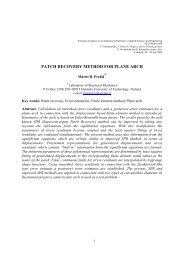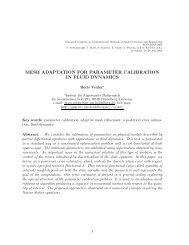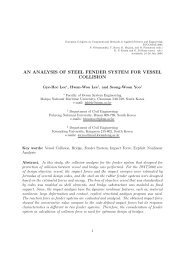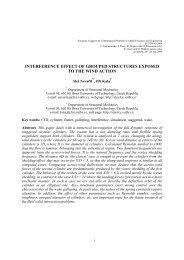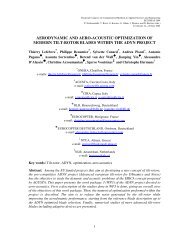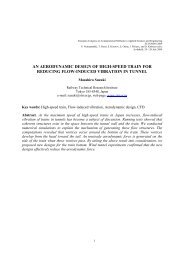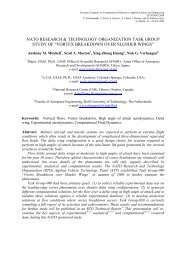Aerodynamic Design of Unmanned and Scaled Supersonic ...
Aerodynamic Design of Unmanned and Scaled Supersonic ...
Aerodynamic Design of Unmanned and Scaled Supersonic ...
Create successful ePaper yourself
Turn your PDF publications into a flip-book with our unique Google optimized e-Paper software.
K. Yoshida <strong>and</strong> Y. Makino<br />
completed in the middle <strong>of</strong> 2003. The aim <strong>of</strong> the<br />
flight test will be to ensure the practicality <strong>of</strong><br />
applying the design method to real aircraft<br />
design. The flight test plan <strong>of</strong> the NEXST-2<br />
airplane is summarized in Figure 2. Several<br />
technical data will be measured at supersonic<br />
<strong>and</strong> subsonic flight.<br />
The first flight test <strong>of</strong> the NEXST-1 airplane<br />
was conducted on the 14 th <strong>of</strong> July in 2002.<br />
Unfortunately the test was a failure, because <strong>of</strong><br />
unexpected early separation <strong>of</strong> the booster due<br />
to an electric short on the firing system <strong>of</strong><br />
separation bolts. The failure resulted in the<br />
M=0.8 at H=12 km<br />
NEXST-2 program being frozen until the success <strong>of</strong> the flight test <strong>of</strong> the NEXST-1 airplane.<br />
Since then, we have improved <strong>and</strong> redesigned the whole system. The next flight test is<br />
scheduled for the end <strong>of</strong> 2004. We really do our best to realize the successful fight test <strong>of</strong> the<br />
NEXST-1 airplane.<br />
Present paper describes details <strong>of</strong> the aerodynamic design <strong>of</strong> both experimental airplanes.<br />
2 AERODYNAMIC DESIGN OF NEXST-1 AIRPLANE<br />
In general, we have the following st<strong>and</strong>points in the aerodynamic design <strong>of</strong> the advanced<br />
SST: reducing supersonic drag, reducing sonic boom, improving subsonic aerodynamic<br />
performance, compromising aerodynamics <strong>and</strong> structures, <strong>and</strong> suppressing aerodynamic noise.<br />
However as the first step <strong>of</strong> developing these advanced technologies, we mainly focused on<br />
improving lift-to-drag ratio (L/D) at supersonic <strong>and</strong> subsonic speed in the flight test program,<br />
because improving L/D is the most key technology in all development <strong>of</strong> SST. Furthermore,<br />
reducing sonic boom <strong>and</strong> improving take-<strong>of</strong>f/l<strong>and</strong>ing performance with high lift device are<br />
also important. Therefore, they are investigated as fundamental reserach activities.<br />
In the aerodynamic design <strong>of</strong> the NEXST-1 airplane, main target was placed on reducing<br />
supersonic drag only, because this configuration is clean – that is, it is an aerodynamically<br />
pure shape. Therefore, we can obtain the optimum effect <strong>of</strong> combining several drag reduction<br />
concepts. In the NEXST program, we developed advanced aerodynamic design technology<br />
according to the following philosophy: to design mathematically along the logical process<br />
without any empirical parameters <strong>and</strong> to incorporate some innovative technologies.<br />
To design the NEXST-1 airplane, first <strong>of</strong> all, we had to specify some typical requirements<br />
on an expected real SST aircraft such as fuselage length, volume, tail shape <strong>and</strong> position. We<br />
selected the following dimensions, referring the study [1] <strong>of</strong> JADC (Japan Aircraft<br />
Development Corporation) <strong>and</strong> other foreign papers: M=2 (cruise Mach number), C L =0.1<br />
(cruise lift coefficient), H=15km (flight altitude), S=9000 ft 2 (wing area), L=300 ft (fuselage<br />
length), V=30000 ft 3 (fuselage volume for 300Pax) <strong>and</strong> scaled tail configurations <strong>of</strong> the<br />
Concorde. Then, we selected a scale ratio <strong>of</strong> 11% <strong>of</strong> the real SST aircraft dimensions above.<br />
However, tail cone length <strong>of</strong> the scaled fuselage was slightly extended to keep the<br />
fire-on<br />
take-<strong>of</strong>f<br />
M=1.7 at H=15 km<br />
Test region<br />
separation<br />
data-link<br />
l<strong>and</strong>ing<br />
engine cut-<strong>of</strong>f<br />
X-38 scaled<br />
model<br />
Figure 2. Flight test plan <strong>of</strong> NEXST-2 airplane<br />
3



